Filippo Cardella
巴士末排
The last row of the bus
3:00
Get drunk and hustle or hate your job,
你喝醉了,或许讨厌你的工作,
all day we struggle, until we drop.
我们日夜工作,直至倒下。
†
You’ll feel immortal in your black tie,
你打著黑色领带,会觉得自己不朽,
you’ll work so hard and then you’ll die.
你会努力工作,然后死去。
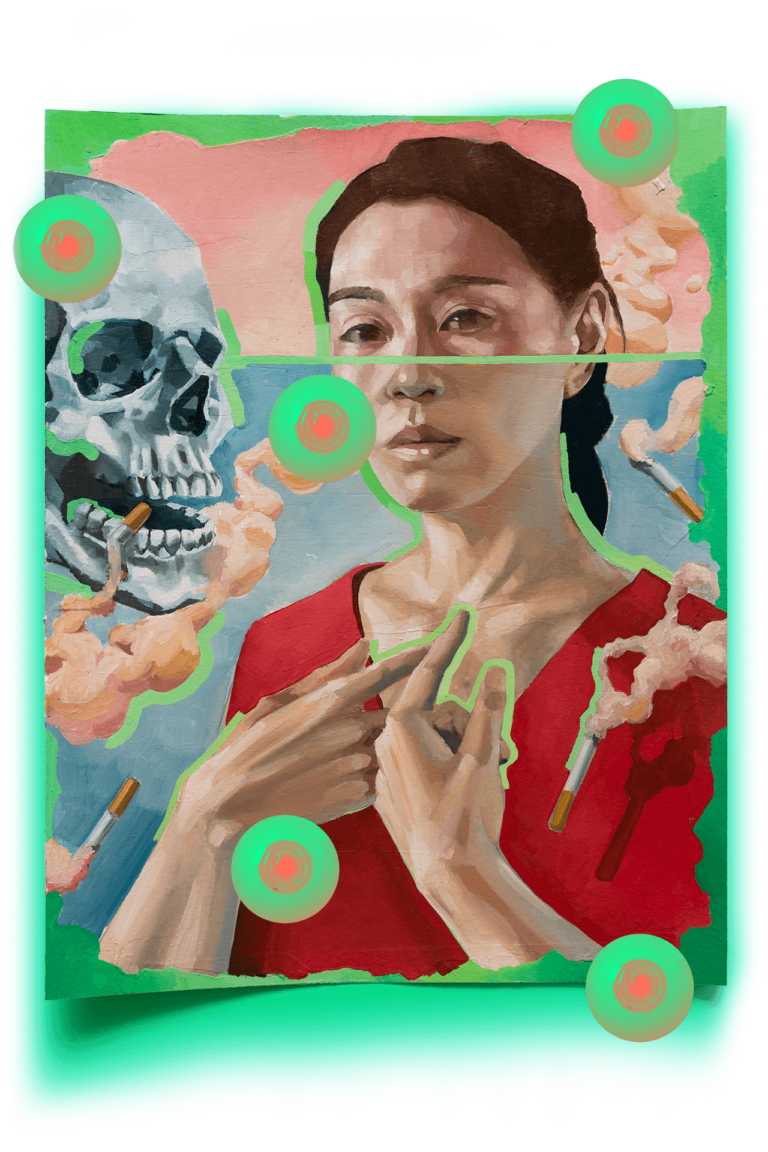
Or you will sing your silly song
或者你会一直唱着你那愚蠢的歌,
until the sound of the last gong.
直到最后一声锣响。
†
All lives end up with a reward:
所有的生命最终都会得到回报:
the pricey bill of the good lord.
上帝的高价账单。
†
Life is on your side like a big thorn,
生命就像一根大刺扎在你身旁,
we are only dust, no one return.
我们只是尘土,无人回头。
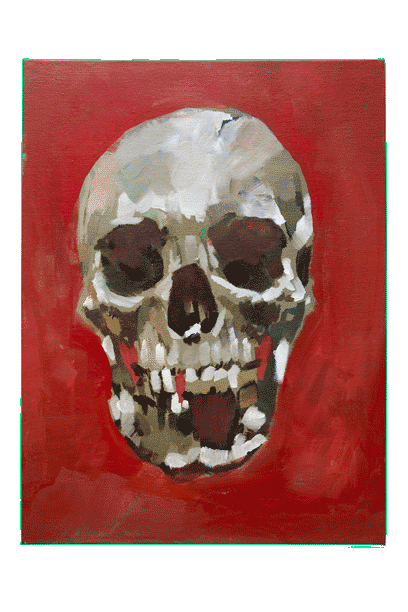
the word ‘goodbye’ is a vacuum pump,
“再见”这个词就是个真空泵,
you can’t deny we are sad and dumb.
你不能否认我们是悲伤和愚蠢的。
†
I am sorry mate, but soon it’s late,
我很抱歉,伙计,但是很快就要迟到了,
full of regret you’ll meet your fate.
你将要面对你的命运,满怀悔恨,
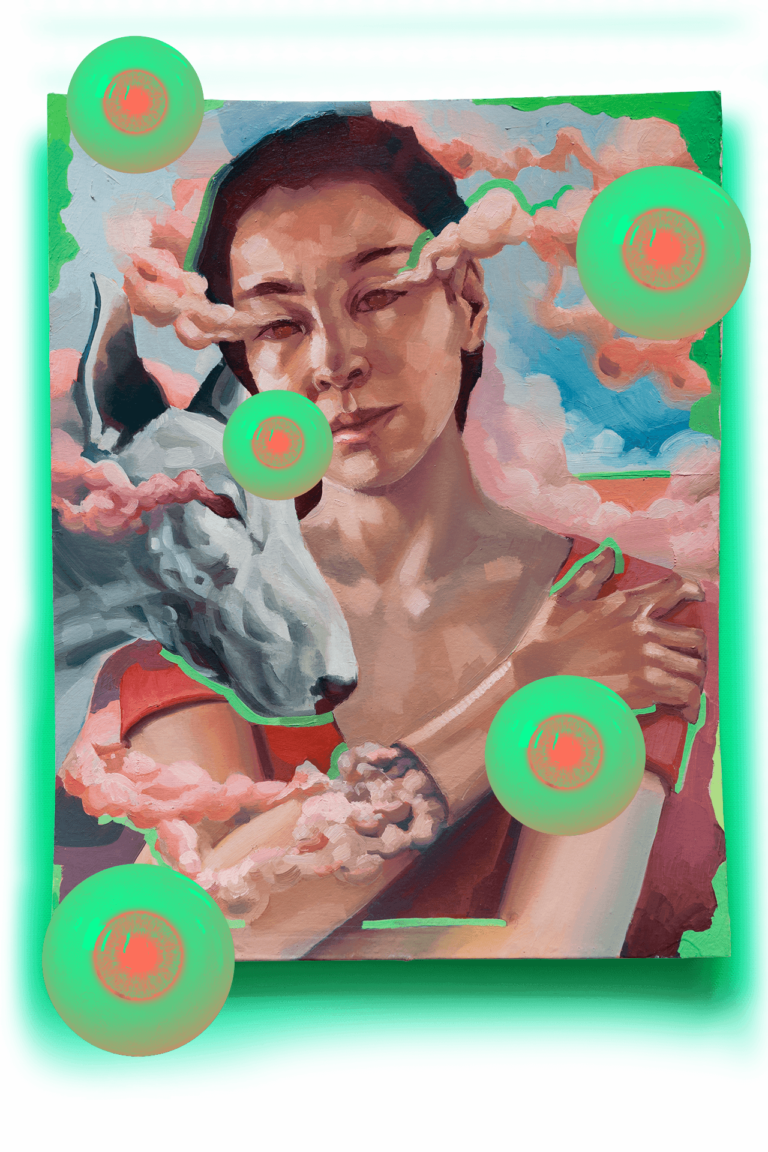
Some have a dream that they sell out,
有些人心怀梦想不惜出卖自己,
Some get in jail and don’t get out.
有些人进了监狱并无法脱身。
†
Maybe you’ll live, no war to fight,
也许你会活下来,没有战争可打,
or you’ll get shot, like a luddite.
或者你会像勒德分子一样中枪。
†
For now we are, in this bazaar,
现在我们,在这个集市,
we dream a flare although is dark.
我们梦到一个光斑,尽管它暗淡。
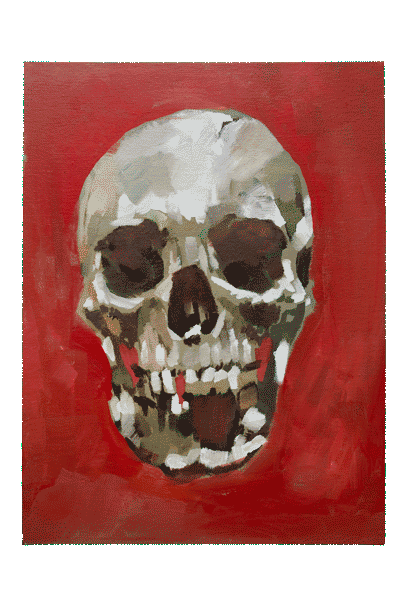
So much we care but we can’t touch.
我们如此牵挂,却无法接触。
All time we have is not so much.
我们所拥有的时间已所剩不多。
†
On the treadmill our stories roll,
在跑步机上,我们的故事滚动,
you can’t go back or take control.
你无法倒回或控制。
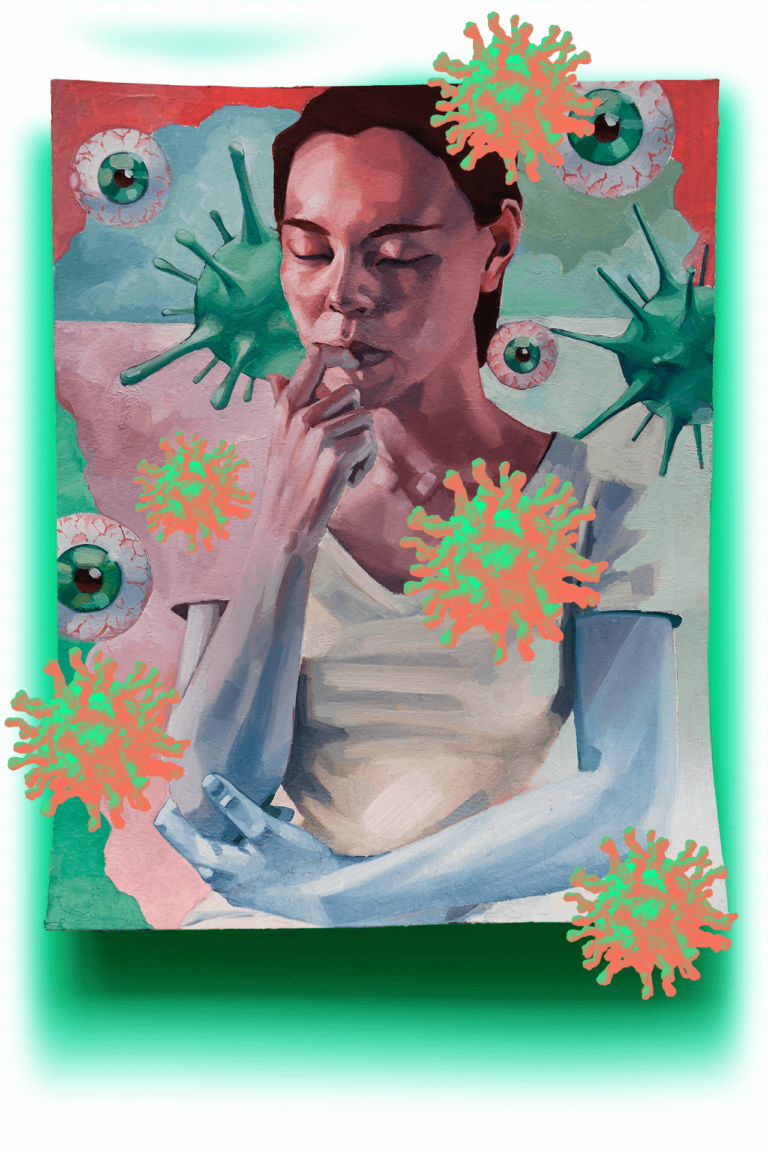
On the Doomsday the saints will pray,
在世界末日,圣徒们会祈祷,
while we may say: “Mayday, mayday!”
而我们可能会说: “救命,救命! ”
†
Hard to remember or to go further,
很难记得,或者更进一步,
maybe ahead there is a murder.
也许前面有一起谋杀案。
†
Lost in the sea without a map;
在没有地图的情况下迷失在海里;
all life awake until we snap.
所有的生命都醒着,直到我们崩溃。
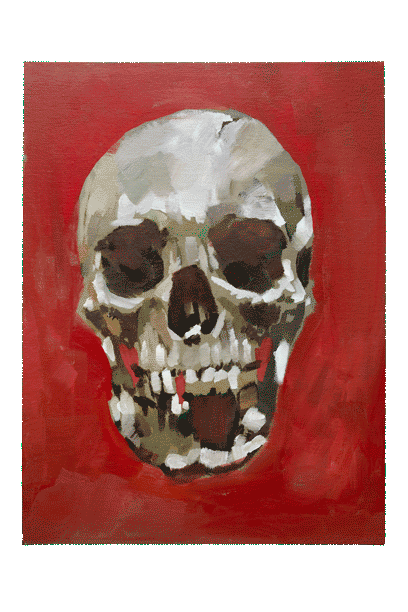
In the last row of this old bus
在这辆老巴士的最后一排,
the almighty driver will not hear us.
全能的司机听不见我们的声音。
†††
巴士末排The last row of the bus
人类正面临着真实而又模糊的生存威胁: 原子弹、气候变化或人工智能都是很好的例子。但我们正在经历的全球性流行病,让我们明显感觉到生命无常。
这次意外事件造成的损失,让我回想起了 14 世纪,当时欧洲突然遭到瘟疫,或者说黑死病——人类历史上最致命的流行病的摧残。 那是一个前科学时代,对死亡的宗教与精神性质的阐释仍占主导地位,两个紧密联系的艺术主题在这个基督教的大本营已经确立: memento mori (拉丁语“记住你终有一死”)和 danse macabre (“死亡之舞”)。
虽然 memento mori 与基督教对来生的解释紧密相连,但 danse macabre 采用了更世俗的视角来反思生命的 sine qua non (“必要条件”):死亡。 为了试图在当代重现死亡舞蹈,我创作了一首童谣,融合了视频图像,油画和图形元素。 不同媒介的并置——就像一个梦境的凝固画面——创造出一种类似歌曲或舞蹈节奏的结构。
对流行病的分析不能仅仅通过科学或技术方法实现,以艺术作品形式呈现出的对疾病的分析也不能仅仅用科学艺术的思维解读。 作品的超现实主义美学包含了死亡的神秘本质,这是一种在认识死亡的内心苦旅中过渡到接受阶段的一种尝试。这件艺术品到底表现了关于悲伤的哪个阶段?谁也无法给出确切的答案。但我猜想在这些图像背后是一种持续的来自无意识层面的否认,也许正因为我们仍然存在于世时,无法理解“不存在”这个概念,我们才会下意识否认死亡的事实,拒绝接受现实。
Humanity is facing real —and yet still vague— existential threats: the atomic bomb, the climate change, or artificial intelligence are all good examples. But the global pandemic we are experiencing gave us all a palpable sense of the impermanence of our lives.
The disorientation derived from this unexpected event made me look back at the 14th century when Europe was suddenly devastated by the plague, or Black Death, the most fatal pandemic in human history. It was a pre-scientific world and the religious and spiritual interpretation of death was still dominant. Two strictly connected artistic themes were already well established in that Christian stronghold: the memento mori and the danse macabre or dance of death.
While the memento mori is strictly connected to the Christian interpretation of the after-life, the danse macabre adopts a more secular perspective to reflect on the sine qua non condition of life: death. In an attempt to re-create a contemporary danse macabre I composed a nursery rhyme that blends with video images, oil paintings, and graphic elements. The juxtaposition of the different media —like frozen frames of a dream— creates a sort of structure like in the rhythm of a song or a dance.
The analysis of the pandemic through an artwork can not be reached exclusively through a scientific or technical approach. The surrealistic aesthetic of the work embraces the mysterious nature of death and it is an attempt to embark on a difficult journey towards its acceptance. Which stage of grief has been reached with this artwork is still to be determined but I suspect that behind these images there is an ongoing unconscious denial and this rejection is probably caused by the impossibility of grasping the idea of ’not to be’ while we still exist.
在艺术品中找到意义
Finding meaning in the artwork
巴士末排
万里行
《巴士末排》(The Last Row of the Bus)是意大利艺术家 Filippo Cardella 的作品,他用这个多媒体作品来反映他对流行病的体验,同时在表达了普遍的人类主题的层面的隐喻: 死亡。 这件作品包括一个视频,和这个系列同名,还有三幅油画: 否认、愤怒和接受。 视频是艺术品意义的关键容器。 它以一个军事葬礼的场景开始: 一个士兵站在一片看似无尽的墓地中央,吟唱着 il silenzio(“寂静”)的旋律,这首著名的歌曲经常伴随着官方对那些为更高事业而牺牲的人的庆祝。 然而,不一会,这个看似壮观的场面变成了非常不同的东西,即对生命的无意义的怪诞叙述。 一个类似机器人的声音背诵着一首童谣,让我们想起了虚无主义者的独白,就像我们在《猜火车》的开头,丹尼 · 博伊尔的杰作。 为什么我们如此挣扎,为什么我们如此认真对待自己,如果等待我们的是,不可避免的,死亡的虚无?
就像病毒一样,死亡并不关心社会阶层,种族,政治倾向,财富等等。 死亡就像新型冠状病毒肺炎一样,平等地对待每一个人
在这个意义上,Cardella 的作品与西方艺术史上的传统流派,特别是“死亡之舞“(danse macabre)紧密相关,艺术家明确提到。 作为死亡的象征,“死亡之舞”的起源还不确定,但很多人将其追溯到黑死病,这种疾病也将中世纪世界撕成粉碎。 最早的令人毛骨悚然的舞蹈壁画是 1424-1425年在巴黎圣婴公墓(Cimitière des Innocents)的壁画。 1669年被毁,我们知道它的存在,多亏了巴黎印刷商盖奥 · 马尔尚(Guyot Marchant)的出版物,他在 1485年出版了一本插图书: 这本书中的木刻画经常被重印,这反过来促进了这一流派在整个欧洲的流通。 “死亡之舞”是游行或舞蹈的表现,死者和生者共享舞台。 传统上,这种类型的作品是一种独特的社会信息的注释: 死亡平等地对待我们所有人。 就像病毒一样,死亡并不关心社会阶层,种族,政治倾向,财富等等。 死亡就像新型冠状病毒肺炎一样,平等地对待每一个人。
《否认》(Denial)是 Cardella 作品的一部分,有“死亡之舞”的传统渊源。 在照片里,死人和活人在一起跳着舞。 一个穿红裙子的女人站在画布中央,面对着观众。 手指着脖子的方向,她好像在问“为什么是我?” 但是没有答案。死亡没有理由,这是人类生活中不可避免的事实。 她的眼睛似乎有点泛红,这让人怀疑她是不是刚刚哭过,绝望地面对着她的命运,那不可能只是虚无。 在她的右边,一具骷髅正在抽烟: 烟雾弥漫在她的周围,仿佛是一个致命的拥抱。
用艺术家的话来说,否认也许是我们永远被限制的唯一阶段,不仅在流行期间,而且在我们的日常生活中。 正如 Damien Hirst 在《生者对死者无动于衷》中所言,人类无法揣测自己的终极命运。 然而,也许这并不是说,人类的生命毫无意义。
Cardella并没有给我们准确的答案: 他认为艺术创作是无意识的,通常可以根据观众的理解进行。 用他的话来说,艺术并非是一本固定的,清晰的宜家信息指导手册。 艺术,作为生活,总是充满了“误解”。 正如安伯托·艾柯(Umberto Eco)的符号学中提到的“异常交流”(aberrant communication),是我们的生活毫无意义么? 也许,就像在《猜火车》的结尾,通过“展望未来,展望你的一天”,你仍然可以在你的日常生活中找到意义。
By Wan Lixing
The Last Row of the Bus is a work by Italian artist Filippo Cardella, who used this multimedia piece as a way to reflect on his experience of the pandemic, while at the same time drawing implications at the level of a universal human theme: Death. The work includes a video, which carries the same title of the series, and three oil paintings: Denial, Anger, and Acceptance. The video is the key vessel of the artwork’s meaning. It begins with a scene from a military funeral: A soldier standing in the middle of what appears as an endless field of tombs intones the melody of Il Silenzio (“The Silence”), the famous song that often accompanies official celebrations of those who have fallen serving a higher cause. And yet, after a few bars, this seemingly dignifying spectacle turns into something very different, that is, a grotesque narration of the meaninglessness of life. A quasi-robotic voice recites a nursery rhyme that reminds us of nihilist monologues such as the one we can here in the opening sequence of Trainspotting, Danny Boyle’s masterpiece. Why are we struggling so much, why are we taken ourselves so seriously, if what awaits us is, inescapably, the nothingness of death?
“Just like the virus, death doesn’t care about social classes, ethnicities, political affiliation, wealth, and so on. Death, just like Covid-19, treats us all equally”
In this sense, Cardella’s work significantly connects with traditional genres in the history of western art, and in particular the danse macabre, which the artist explicitly mentions. A memento mori, the origin of the “dance of death” is uncertain, but many trace it back to the Black Plague, a disease that also broke the Medieval World into pieces. The earliest pictorial example of a danse macabre is a mural painted in 1424–5 in the cloisters of the Cimitière des Innocents in Paris. Destroyed in 1669, we know of its existence thanks to a publication of the Parisian printer Guyot Marchant, who in 1485 published an illustrated book: the woodcuts in the book were often reprinted, and this in turn was instrumental for the circulation of the genre throughout Europe. The dance of death is a representation of a procession or a dance where the dead and the living share the stage. Traditionally, works in this genre are a commentary with a distinct social message: Death treats all of us equally. Just like the virus, death doesn’t care about social classes, ethnicities, political affiliation, wealth, and so on. Death, just like Covid-19, treats us all equally.
Denial is the part of Cardella’s work that more closely connects to the tradition of the dance macabre. In the picture, the dead and the living are dancing together. A woman in a red dress occupies the center of the canvas, while facing the viewer. With her hands pointing in the direction of her neck, she seems to ask: “Why me?” But there’s no answer: There is no reason for death, which is an ineluctable fact of human life. Her eyes seem slightly reddish, a feature that makes one wonder whether she had just cried, desperate in facing her destiny, which can’t be but nothingness. To her right, a skeleton is smoking a cigarette: The smoke pervades her whole surrounding, in what appears as a mortal hug.
In the words of the artist, denial is perhaps the only stage where we are always confined, not only during the pandemic, but in our daily lives. As Damien Hirst suggests in The Physical Impossibility of Death in the Mind of Someone Living, humans can’t fathom their ultimate doom. And yet, perhaps this is not to say that human life is meaningless.
Cardella doesn’t provide us with exact answers: He believes that artistic creation is unconscious and generally open to the interpretation of the viewer. Art, in his words, does not come with a fixed or clear message to be decoded by using some kind of IKEA instruction manual. Art, as life, is always about “misunderstanding,” as in the aberrant communication in Umberto Eco’s semiotic. Is our life meaningless? Perhaps, just like at the end of Trainspotting, by “looking ahead, to the day you die,” you can still find meaning in your everyday.
Filippo Cardella
我是一名在北京生活的意大利艺术家和设计师。
我在佛罗伦萨艺术工业学院学习平面设计和工业设计,师从于诸如保罗 · 德加内洛(Paolo Deganello),乔治 · 贝雷蒂(Giorgio Berretti )(archizoom)和比亚吉奥 · 西索蒂(cisotti laube studio)等设计大师。 后来我在意大利摄影师奥利维罗 · 托斯卡尼(Oliviero Toscani)的工作室,开始了四年的学徒生涯,在那里我专门从事平面设计。
学徒期结束后,我离开意大利,周游世界(布宜诺斯艾利斯,新加坡,纽约和北京) ,从事平面设计和展览设计。 我为诸如Ralph Applebaum,Gallagher & Associates(加拉格尔和合伙人)等工作室工作过,客户中包括新加坡艺术博物馆。
从很小的时候起,我就对城市亚文化,特别是涂鸦产生了浓厚的兴趣。 我研究了这个主题,并亲自与这些地下社区互动,我策划了几个关于涂鸦的出版物,并组织了一系列活动和艺术展览,专门讨论这个主题。
在过去的几年里,我参加了一系列的艺术展览,主要是关于城市环境及其亚文化的作品。 我的主要创作媒介是油画颜料,丙烯酸和喷漆,但我也制作艺术装置,雕塑和视频。
I am an Italian artist and designer based in Beijing.
I studied graphic and industrial design at the Institute of Artistic Industries of Florence under the teachings of design masters like Paolo Deganello, Giorgio Berretti (Archizoom), and Biagio Cisotti (Cisotti Laube Studio). I later started a 4 years apprenticeship at the studio of the Italian photographer Oliviero Toscani, where I specialized in graphic design.
After the apprenticeship, I left Italy and traveled around the world (Buenos Aires, Singapore, New York, and Beijing) working as a graphic and exhibition designer. I worked for studios like Ralph Applebaum, Gallagher & Associates, and with clients like the Singapore Art Museum.
From a young age, I developed a keen interest in urban subcultures and graffiti in particular. I studied the topic and personally interacted with these underground communities, I curated and contributed to several publications about graffiti and organized a series of events and art exhibitions dedicated to the topic.
During the last few years, I participated in a series of art exhibitions with a body of works mainly focused on the urban environment and its subcultures. My main medium is oil, acrylic, and spray paint but I also produced art installations, sculptures, and videos.
In 2019 I founded Difforme, an art and design studio based in Beijing (difformestudio.com).